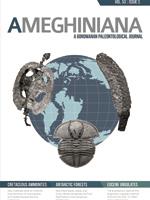Basal fully aquatic whales, the basilosaurids are worldwide known from Bartonian—Priabonian localities, indicating that this group was widely distributed during the late middle Eocene. In the Northern Hemisphere, fossils of basilosaurids are abundant, while records in the Southern Hemisphere are scarce and, in some cases (i.e., Antarctica), doubtful. The presence of basilosaurids in Antarctica was, until now, uncertain because most of the records are based on fragmentary materials that preclude an accurate assignment to known archaeocete taxa. Here we report the findings of mandibles, teeth, and innominate bone remains of basilosaurids recovered from the La Meseta Formation (TELM 4 Lutetian—Bartonian and; TELM 7 Priabonian), in Marambio (Seymour) Island (James Ross Basin, Antarctic Peninsula). These findings confirm the presence of Basilosauridae in the marine realm of Antarctica, increasing our knowledge of the paleobiogeographic distribution of basilosaurids during the middle—late Eocene. In addition, one of these records is among the oldest occurrences of basilosaurids worldwide, indicating a rapid radiation and dispersal of this group since at least the early middle Eocene.
El registro fósil de los basilosáuridos está bien documentado durante el Bartoniano—Priaboniano en varias localidades del mundo, lo cual indica que este grupo estaba ampliamente distribuido durante el Eoceno medio tardío. En el Hemisferio Norte, el registro fósil de este grupo es abundante, a diferencia de lo que ocurre en el Hemisferio Sur donde es escaso y, en algunos casos (i.e., Antártida), dudoso. La presencia de basilosáuridos en Antártida es incierta ya que la mayoría de los registros están basados en materiales fragmentarios, lo cual imposibilita su asignación a algún grupo de arqueocetos. En la presente contribución se describen restos de basilosáuridos correspondientes a mandíbulas, dientes aislados y un hueso pélvico, recuperados de la Formación La Meseta (TELM 4 Lutetiano—Bartoniano; TELM 7 Priaboniano), Isla Marambio (Seymour), (Cuenca James Ross, Península Antártica). Este hallazgo confirma la presencia de Basilosauridae en la Antártida, contribuyendo al conocimiento de la distribución paleobiogeográfica de este grupo durante el Eoceno medio—tardío. Finalmente, uno de estos registros se encuentra entre los basilosáuridos más antiguos conocidos, indicando un rápida radiación y dispersión de este grupo al menos desde el Eoceno medio temprano.





